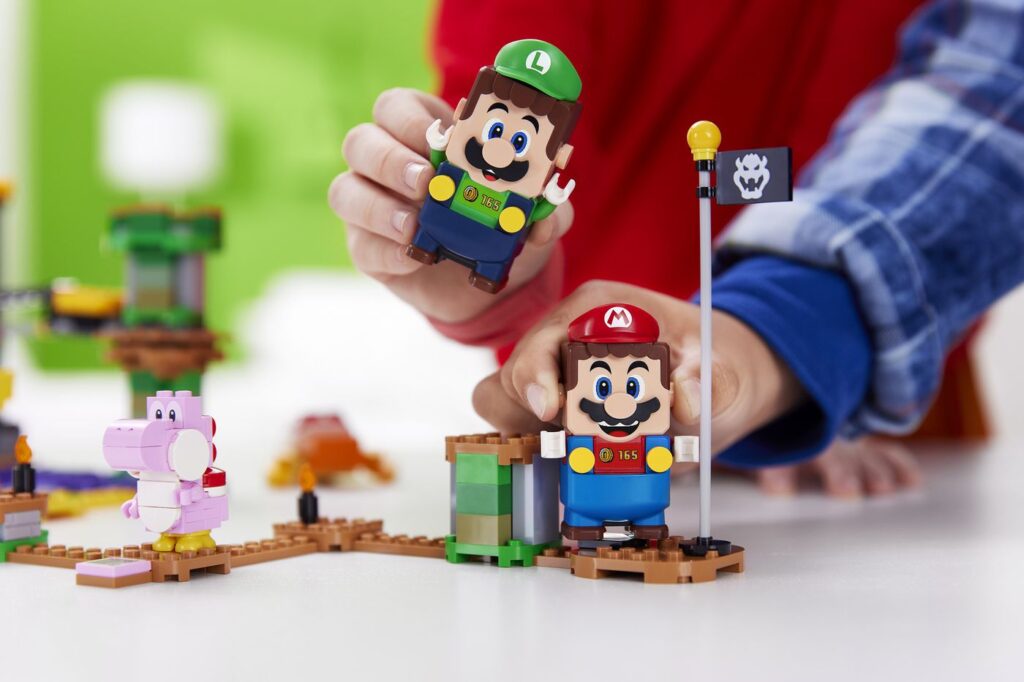
Super Mario, one of the big names of 1980’s video games, has made a huge resurgence in recent years thanks to Nintendo offering new games exclusively and LEGO creating a Super Mario series.
LEGO Super Mario
LEGO Super Mario allows kids and adults to build an obstacle course complete with characters, buildings and landmarks from the game. LEGO Mario is equipped with a tiny scanner (that reads QR codes and colours), and an accelerometer which registers his orientation. As the course is traversed, players propel Mario to run, jump and scan codes on specific blocks. Scanning earns coins, plus unlocks bonuses and stronger fighting abilities. The scanner also identifies colours to determine whether Mario is on grass, sand, bricks or lava. Most children are taught from an early age to avoid lava, and have the opportunity to apply this learning as part of the game.
Watch this quick video to learn more about the experience.
And Luigi too!
Having won ‘Playset of the Year’ at the prodigious Toy Of The Year Awards 2021, LEGO Super Mario evolution shows no sign of slowing down. Mario has now been reunited with his brother Luigi, with the release also accompanied by a new range of expansion sets.
Player stimulation is key
LEGO Super Mario incorporates an astonishing arrange of design features aimed at stimulating player engagement, something which should inspire loyalty program designers everywhere.
When starting a game, the first scan is a ‘question mark’ block. This awards the player either 15 seconds bonus time, mushroom power (reduced Mario’s likelihood of being stunned if he falls off a platform or crashes into a piranha plant), star power (provides the ability to kill all enemies with a single scan and earn double coins), or bonus coins. These mystery bonuses right from the start immediately convey a sense of progress, while the surprise aspect of the reward injects a sense of delight (manifesting in emotional engagement).
As players work their way through the course they are provided with various blocks to scan, earning bonus coins. Accompanying sounds and pictures flash up on the screen on Mario’s chest to reinforce the achievement, reminiscent of a slot machine. An important feature of the game is earning the maximum number of coins possible, with the connecting mobile app recording the total coins earned over Mario’s lifetime. This drive to earn engages the player mentally, stimulating them to attempt a variety of strategies to boost coin accrual, and occupying their mind well beyond the completion of the game.
The game runs on a timer, with players provided just 60 seconds to traverse the course, although some expansion sets come with bonus time tiles. Irrespective, the time pressure enhances the engagement by making the entire activity more challenging and thrilling, including injecting a risk element whereby they may lose their earned coins if they fail.
And all this is before players explore all the other features; there’s Bowser’s Castle, the Guarded Fortress, tiles which multiple the coins you earn, treasure boxes, Wiggler, lava bridges, Whomp, and even Mario’s friends (including Toad, Toadette and Yoshi), all of which compel the player to continue their rush towards the end goal.
Loyalty program design lessons
What is the lesson here for loyalty programs?
It’s the obsessive focus on player stimulation. Most loyalty programs are intensely boring and predictable, following a centuries old model of earn and reward with little enhancement other than repeat assault via generic promotional marketing emails. LEGO Super Mario demonstrates a range of stimulation elements which can be applied to loyalty programs to motivate members to learn, earn, burn and refer. This includes surprise and delight features, overt celebration of achievements, multiple bonus earn opportunities, time pressure and loss aversion, varying landscapes and experiences, continual novelty and regular release of new pathways to more enjoyment.
Clearly, most adult consumers who are the primary target of loyalty programs are not going to be inspired to play LEGO Super Mario. But the underlying psychology of what makes this work for children can be translated into a loyalty program design which will appeal to the child in the target member. Typically, what is lacking in a company’s loyalty program team is a sense of imagination and the bravery to try something new.
At the very least, LEGO Super Mario provides an opportunity to look at the program’s design with a fresh view and ask the only design question that really matters –
WHAT IF?

